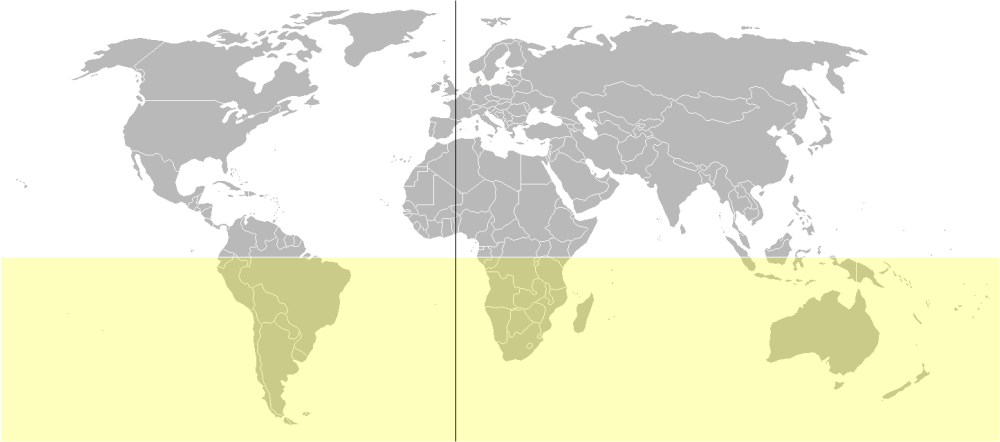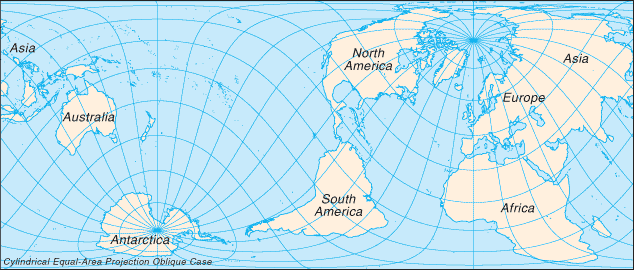Although schools in the U.S. are on vacation now because of the Christmas and New Year’s holidays, do you know when schools in other countries begin their academic year? It makes a difference if you have children arriving mid-way through your own school year because the decision about which grade the student should be placed in is not always an easy one.
 |
| Countries in the Southern hemisphere shaded in yellow; source: Wikimedia Commons |
Issues When Students Arrive in the Middle of the School Year
I first became aware that not all schools started their year in September when there was a possibility I would go to South America as a high school exchange student. I was told I’d be departing in February because that’s when their school year began. At the time, that seemed so strange! Since then, I have taught plenty of students who came from Latin America and began class with me in January or February -- their families finished out the year in their home countries and then came to the U.S.
Aside from the issue of having students come during the middle of the year, with all that entailed of integrating them into my class, the biggest issue was always what grade the child should be placed in. Usually, it would be the one after whatever grade the student had just finished. But we also took into consideration other factors, including parent input, courses taken, and grades on transcripts.
What I learned, after spending many years on the team that registered ELLs who were new to my school district, was to look very carefully at the date of birth and the grade that a student most recently completed, and discuss the options with the family when there were two possibilities regarding the grade their child could be placed in. While the team could not recommend a specific grade placement, we could point out to the school principal, who was the one making the final decision, if a student would be much younger or older than most of the rest of the kids in the grade the student should be in according to his or her transcript. Most of the time, things worked out fine.
Aside from the issue of having students come during the middle of the year, with all that entailed of integrating them into my class, the biggest issue was always what grade the child should be placed in. Usually, it would be the one after whatever grade the student had just finished. But we also took into consideration other factors, including parent input, courses taken, and grades on transcripts.
What I learned, after spending many years on the team that registered ELLs who were new to my school district, was to look very carefully at the date of birth and the grade that a student most recently completed, and discuss the options with the family when there were two possibilities regarding the grade their child could be placed in. While the team could not recommend a specific grade placement, we could point out to the school principal, who was the one making the final decision, if a student would be much younger or older than most of the rest of the kids in the grade the student should be in according to his or her transcript. Most of the time, things worked out fine.
However, on occasion there were problems when I had students who, chronologically, were one or even two years younger than their classmates because the student hadn’t learned things that the rest of the class had been taught the previous year and/or the student was less mature socially and emotionally than the rest of the class. This second one was more of an issue, in my experience, because those students were less able to handle the workload and their behavior wasn’t always appropriate. That necessitated a lot of discussion with the guidance counselor and the family – by me and with the student -- but often it was just a matter of waiting for the student to age into maturity. Retention, might be raised as a possibility but then, fortunately, was always discarded because it wasn’t right to penalize a student for a lack of maturity since that was such a subjective judgment.
On another occasion, I had a student who was two years older than her classmates. Then, the problem went the other way because she was more mature. Luckily for her, she moved to another school mid-way through the year and jumped a grade, meaning that at her new school, she was only one year older than her classmates.
It can be tricky to balance the academic needs of the child with their social-emotional needs and all decisions need to be made on an individual basis. It can be especially difficult when dealing with students coming from another country who have transcripts in another language that aren't translated. The best advice I have is to talk in-depth with the families and even with the student, if he or she is at least seven or eight years old, using an interpreter if necessary, at the time the family registers, to determine where the student will best fit in and thrive in school.
 |
| World map with continents; source: Wikimedia Commons |
Countries Whose School Year Doesn't Begin in August or September
Below is a partial list of countries where school begins in January or February. The information was compiled from several sources but I couldn’t find exact dates for 2016 for several countries. If you know when the school year in these countries begins, please leave a note in the Comments below so I can add that information to this blog post.
Guatemala = Second Monday of January
South Africa = January 13
Australia = January 27
Kenya = January
Malaysia = Early January
Singapore = Beginning of January
Costa Rica = Early February
Honduras = Early February
New Zealand = Between February 1 – 5
Brazil = First week of February
Chile = Late February
Guatemala = Second Monday of January
South Africa = January 13
Australia = January 27
Kenya = January
Malaysia = Early January
Singapore = Beginning of January
Costa Rica = Early February
Honduras = Early February
New Zealand = Between February 1 – 5
Brazil = First week of February
Chile = Late February
There are other countries that begin later in the year:
Argentina = Beginning of March
South Korea = Beginning of March
Japan = April 1
India = June
Indonesia = Mid-July
Guest posts in the “Education Around the World” series will resume in January. Happy New Year, Everyone!
